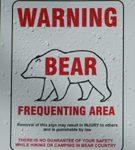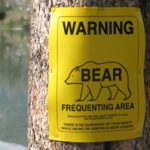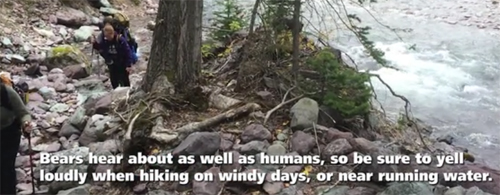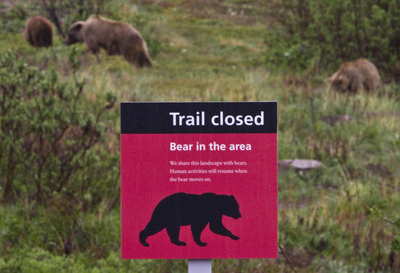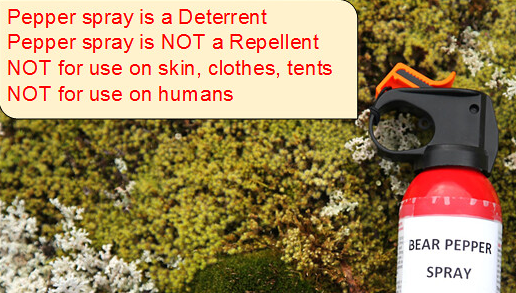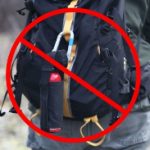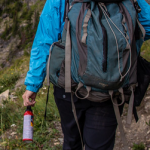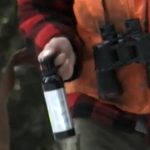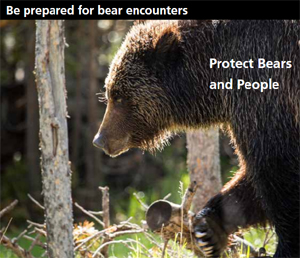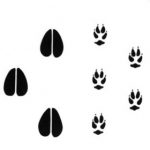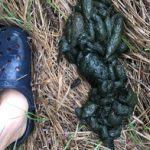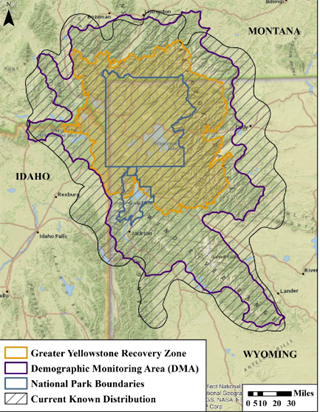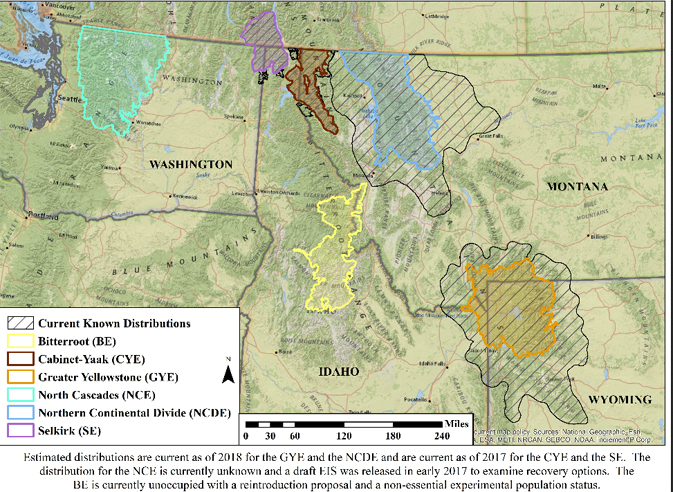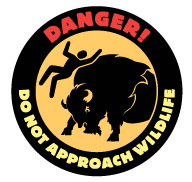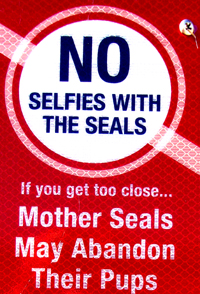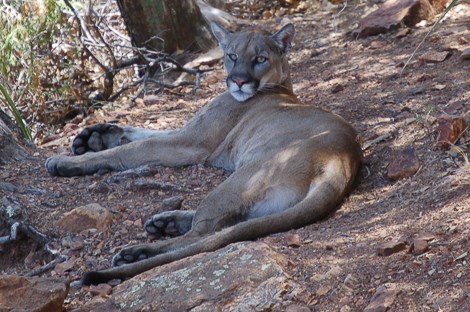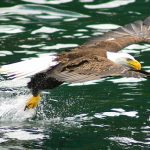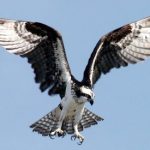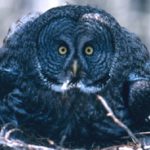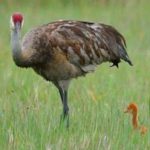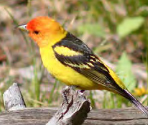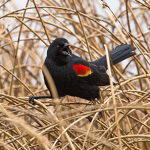This is information for people traveling with the De Anza Outdoor Club about safety in areas frequented by grizzly bears. It is not everything you should know and it can’t be updated as fast or as well as park service information, so please consult park webpages and use the links in this page to go to park webpages.
Bear attacks and other animal attacks are not common,
but there are no guarantees of your safety.
Wild animals try to stay away from people. They become aggressive if:
- they are protecting their cubs/fawns, etc.
- you surprise them
- the bear has become used to people and food rewards from people
- your dog provokes them
- you try to get close to them for a photo, pose near them for a photo, pose your child near them for a photo, try to run by them, pet them, tease them, feed them, throw rocks/stones at them, etc.
people surround them,
even if they stay the minimum 100 yards away. Always leave the bear or other wild animal an escape route.
- you see a bear, get nervous and run. Running can elicit an attack from a non-aggressive bear. A scream or sudden movement may trigger an attack. Never imitate bear sounds or make a high-pitched squeal.
- you somehow are not careful enough and a bear gets your food — and — you try to get it back.
- people fly drones around/over them, endangering themselves and others. Use of drones is illegal in National Parks. Please try to get the vehicle license number (and if possible make, model and color) / campsite number of anyone using a drone and report them to Rangers. If you have cell phone coverage, call park dispatch. The phone number for dispatch is usually in the park newspaper you receive when you enter the park. (When people fly drones around forest fires, the helicopters with firefighters and tankers with sprays to put out the fire can’t fly!)
About selfies: “The popularity of smart phone photography with its limited zoom capacity and social media sharing of selfies might explain why visitors disregard park regulations and approach wildlife more closely than when traditional camera technology was used.” is from a CDC (Centers for Disease Control and Prevention) Morbidity and Mortality Weekly Report (MMWR)
https://www.cdc.gov/mmwr/volumes/65/wr/mm6511a5.htm
Each trip member should be certain to
read current info when they enter any park we travel to
consult with rangers before hikes and bike rides
talk loudly, sing, shout, clap hands or otherwise make noise on the trail (‘bear bells’ do not work)
The NPS says:
“When hiking, periodically yell “Hey bear!” to alert bears to your presence, especially when walking through dense vegetation/blind spots, traveling upwind, near loud streams, or on windy days. Avoid thick brush whenever possible.”
“Bear bells may be a popular item to put on your backpack, but they don’t effectively warn a bear you’re in the area. Bears won’t hear the bells until you’re too close. Yelling, clapping, and talking are more effective ways of alerting a bear to your presence.”
never hike, run or bike alone It is best to do in groups of minimum three and trail running is discouraged as you can come too fast up on a bear. Trail running with ear buds is even more dangerous. (And not hiking alone or doing trail running or hiking with ear buds is a rule for our trips, not just a suggestion.)
don’t hike at dawn, dusk, or at night “Avoid hiking at dawn, dusk, or at night: during summer, that’s when grizzly bears are most active.”
don’t expect bears to see you first “bears hibernate for approximately five months each year and have only seven months of active time to obtain all of their nutritional needs. A bear that’s feeding may not see you as quickly as you would think. Pay attention, and see the bear before it sees you…and before you surprise it.”
stay on maintained trails “Research in Yellowstone has shown that people are more likely to be attacked by a bear when hiking off-trail.”
stay away from dead animals as bears may attack to defend their food
store food properly according to current methods.
watch for, read and obey warning signs
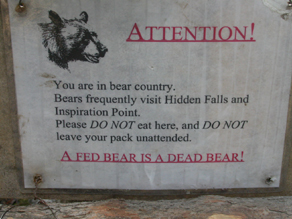
be alert “See the bear before you surprise it. Watch for fresh tracks, scat, and feeding sites (signs of digging, rolled rocks, torn up logs, ripped open ant hills).”
never approach a bear (stay at least 100 yards from bears)
do not run from a bear
Never imitate bear sounds or make a high-pitched squeal.
 NEVER ignore trail closures.
NEVER ignore trail closures.
You could go to an area / trailhead you have often visited and find a warning you must heed:
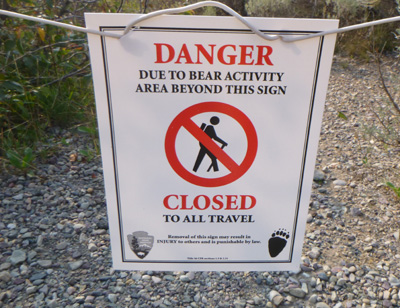
————————————————
 Trip cost for each each Grand Teton National Park trip member includes part of the cost of bear spray, which is required for everyone to carry. Each trip member is required to read about bear spray and watch a video (see below) before they go hiking, biking, kayaking or even walking away from developed areas.
Trip cost for each each Grand Teton National Park trip member includes part of the cost of bear spray, which is required for everyone to carry. Each trip member is required to read about bear spray and watch a video (see below) before they go hiking, biking, kayaking or even walking away from developed areas.
Read: https://www.nps.gov/grte/planyourvisit/bearsafety.htm
Part of that page has included (as of 2025 and many years previously):
“Using Bear Spray
Bear spray should be used as a last resort when encountering an aggressive or charging bear. Carry bear spray in a place where it immediately available, not in your pack. Keep the safety in place until you are in a situation where you may need to use your bear spray.
If you encounter a bear, grab your bear spray in case you need to use it. Do not spray a bear just because it’s there: only spray a charging or aggressive bear. To use bear spray:
Remove safety clip and hold canister with both hands.
Point nozzle towards bear, aiming at the bears feet.
Wait until the bear is about 30ft away then hold down the trigger for 1-2 seconds. The spray will leave the canister in a cloud.
Continue spraying if the bear continues to charge.
After using bear spray, leave the area. Do not run.”
Please watch this video provided by Yellowstone Park of Kerry Gunther, a Yellowstone National Park Bear Management Biologist, demonstrating how to use bear spray:
In a dozen years of club trips to Grand Teton National Park, no one has had to use (spray) any bear spray, but we always carry it.

Do not spray bear spray on your tent, clothes, etc. Glacier Park warns: “It” (bear spray) “is not intended to act as a repellent. Pre-sprayed objects may actually attract bears.” . . .
And yes, there was a woman in Yellowstone National Park who required (and got) medical help when she doused herself with bear spray.
Yellowstone Park warns:
“Bear spray can explode if it reaches 120 degrees Fahrenheit. Don’t store it in the passenger compartment or near any heat sources.”
“Personal defense, jogger defense, law enforcement or military defense sprays may not contain the correct ingredients, or have the proper delivery system, to stop a charging bear.”
“Under no circumstances should bear spray create a false sense of security or serve as a substitute for standard safety precautions in bear county.”
This was just outside the Colter Bay visitor center in Grand Teton National park:
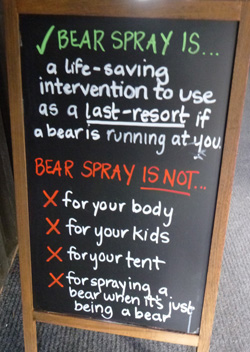
Before the trip we usually have people put on their fully-loaded-for-a-long-hike large day pack / backpack, and put a can of bear spray either in a outside pocket or on a harness, and decide which kind they will want to carry.

Bear spray should be in easy reach, not hanging from the back side of your day pack or backpack,
but it does not need to be out and hand carried.
Grand Teton National park had a video about backcountry travel with a section on bear spray with this:
that shows a can of bear spray tucked in the waistband of a backpack. But we advise people to consider that if they forget it is there and take their pack off quickly, for example to get at their camera for that great picture, the can could fall to the ground and even roll down a cliff side.
A can in a harness would be immediately accessible and more secure.
(For our trips to Grand Teton National Park, you do not need to have bear spray on you while in town, and if you do have it on your person, while shopping for example, the many stores (Albertsons, Target, Ace Hardware, REI and more) in Jackson that sell bear spray might think you took it off a store shelf.)
————————————————
Park rules say do not approach wildlife, stay 100 yards from bears or wolves and 25 yards from other wildlife including nesting birds.
Keep the animal’s line of travel or escape route clear and move away if wildlife approaches you.
How far away is 100 yards? Picture the length of a football field without the end zones.
25 yards? picture four car lengths or six kayak lengths, or the width of an Olympic-sized pool like ours at the college.
If you have an accidental, surprise or inadvertent closer encounter with wildlife you must remove yourself to those distances, including while driving on a road.
Grand Canyon National Park rangers say: “Follow the rule of thumb: if you can cover the entire wild animal with your thumb you’re at a safe distance. This distance is usually 25 yards from most wildlife and 100 yards from large wildlife . . . If you are close enough to take a selfie with an animal, you are too close. ”
Parks Canada warns, along with keeping a proper distance from animals :
“If you spot the following defensive warning signals, pull back even more or leave the area:
Bears make a ‘woofing’ noise, growl and snap their jaws;
Bull elk and moose put their heads down and paw at the ground;
Cow elk flatten their ears, stare directly at you and raise their rump hair.
If you cause an animal to move, you are too close.”
This NPS photo came with this warning:
“when a moose is stressed it will lay its ears back along its head and its hackles will rise.”
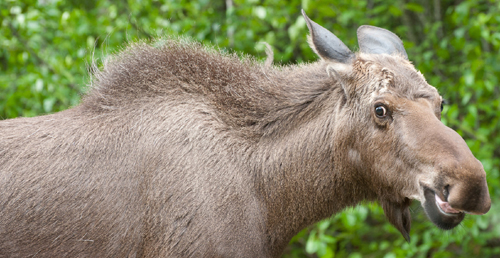
• Denali National park warns: “Moose are not predatory, and they will not try to eat you. Instead, they try to trample a perceived threat.”
See also info on determining safe distances from wildlife, with charts and photos to better be able to determine and visualize how far away from wildlife you need to stay to be safe (and obey laws that do have penalties).
These people are much too close:

– – – – – – – – – – – – – – – – – – – – – – – – – – – – – – – – – – –
Grizzlies are no longer rare in the Grand Tetons and can be found anywhere in the park. In Yellowstone there are 280 to 610 of them. You are more likely in Yellowstone to be hurt by a bison than a grizzly. Read before a bison charges
We will probably not see any grizzlies on our trips, but we should be careful nevertheless. They run faster than you. (Bears can run over 30 miles per hour, or 44 feet per second, seven times faster than the fastest human.) Grand Tetons biking has details about rare fatal encounters between bikers and grizzlies.
Rules for people at bear jams in Grand Teton park changed in 2011, after grizzly 610 twice charged people while they were standing on their car roof. Read about safety at wildlife jams
The Grand Teton park webpages said in 2025 (and for decades previously with a few minor changes:
If you encounter a bear:
DO NOT RUN. Bears can easily out run any human. Running may elicit attacks from non-aggressive bears.
If the bear is unaware of you, detour quickly and quietly.
If the bear is aware but has not acted aggressively, back slowly away while talking in an even tone or not at all.
Use your peripheral vision. Bears may interpret direct eye contact as threatening.
Do not drop your pack – this teaches bears how to obtain human food. Your pack can also protect your body in the case of an attack.
Do not climb trees – all black bears and some grizzly bears can also climb trees.
The vast majority of bear attacks have occurred when people surprised a bear. In this situation the bear may attack as a defensive maneuver. The bear may be protecting young or defending a carcass.
If a bear charges you:
-
DO NOT RUN. Some bears will bluff their way out of a threatening situation by charging, then veering off or stopping suddenly.
-
Bear experts generally recommend standing still until the bear stops and then slowly back away.
-
If you have bear spray this is the time to use it!
-
If the bear makes contact with you, drop to the ground and lie flat on your stomach with your legs spread apart slightly and play dead. Cover the back of your neck with your hands. Keep your pack on to protect your back. Do not move until you are certain the bear has left.
In rare cases, bears have attacked at night or after stalking people. These attacks are very serious: it may mean the bear sees you as prey. If you are attacked at night or if you feel you have been stalked and attacked as prey, fight back. Use your bear spray, shout, and try to intimidate the bear with a stick or rock. In this type of situation, do whatever it takes to let the bear know you are not easy prey.
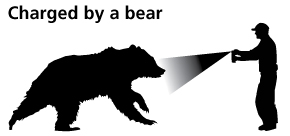
If You Carry Bear Spray
Park visitor centers can demonstrate proper use of bear spray and recycle it. Come visit for more information.
The Grand Teton National Park webpage also said (2025 and previously):
Bear Spray Safety
Make sure you are carrying EPA approved Bear Spray as your bear deterrent, don’t depend on personal defense products to stop a charging bear.
Make sure the canister is immediately available, not in your pack. Attach to the hip belt or shoulder strap of your pack for easier access.
Leave the safety clip on the trigger unless you are ready to spray an aggressive bear. The spray may accidentally discharge otherwise.
Consider the use of bear spray when affected by wind, rain, cold temperatures, and age.
Follow the manufacturer’s instructions, know how to use the spray, and be aware of its limitations, including the expiration date.
If you use the spray to stop a bear, leave the area immediately.
Bear spray is NOT a repellant! Do not spray it on people, tents or backpacks.
Do NOT store your bear spray in a vehicle. It may overheat and explode.
Bear spray is oil based. If you get bear spray on you, remove all affected clothes and wash skin with water.
Under no circumstances should bear spray create a false sense of security or serve as a substitute for standard safety precautions in bear county.
Again, you can read all of that page at: https://www.nps.gov/grte/planyourvisit/bear_encounters.htm
Check out a close encounter with a bear in Yellowstone park, by people who admitted they left their bear spray in the car and will never do so again:
https://www.nps.gov/yell/learn/photosmultimedia/grizzlyvocalizations.htm
The NPS notes with the photo above were: “The position of a bear’s ears often indicates its level of stress. The bear on the left lowered his ears against his skull when the larger and more dominant bear on the right approached. This was likely a sign of defensiveness. Note that the more dominant bear’s ears are still upright. Bears will lower their ears when they react defensively around people too. . .
. . . Look and Listen for Signs of Stress: Vocalizations like woofing, huffing, and jaw popping are almost always indications of stress. If you hear a bear vocalizing then the bear is most likely warning you. The position of a bear’s ears also communicates information. Ears that are pointed forward usually indicate a sense of curiosity or dominance. Ears that are flattened back on a bear’s head is indicative of stress and/or defensiveness.”
“Young grizzlies can climb trees as effectively as black bears, but adult grizzly bears have more difficulty. Most grizzlies can climb a tree if it has ladder-like branches, but their weight and claw structure prevents them from climbing as efficiently as black bears. Three of the 23 documented bear-induced human injuries in Denali involved grizzlies pulling humans out of trees so don’t try to climb a tree to avoid any bear.”
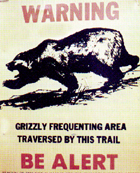
______________________________________
photo below courtesy of NPS:
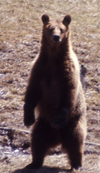
When a bear stands in the movies it is often growling and about to charge, but this is not usual behavior.
Bears are nearsighted. When a real bear in the wilds stands, it often is trying to better smell what it thinks it sees, or see what it thinks it smells.
An Alaska NPS page said: “Bears can see almost as well as people, but trust their noses much more than their eyes or ears.”
A Forest Service webpage said: “Their eyesight is similar to humans and their sense of smell is seven times more powerful than a blood hound’s, enabling them to smell food from miles away.”
__________________________________
 Photos and notes about how to tell the difference between a grizzly and a black bear are at: Rocky Mountain mammal size comparisons
Photos and notes about how to tell the difference between a grizzly and a black bear are at: Rocky Mountain mammal size comparisons
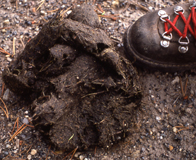 See also: animal sign comparisons
See also: animal sign comparisons
(how to use tracks and scat to distinguish species)
Please do not handle scat. Wolf scat, for example, can transmit tapeworm eggs to humans.
______________________________________

Food and Bears
Proper food and garbage storage is important to the safety and well-being of both bears and humans. Leaving food where bears can get it is not only illegal, but extremely dangerous for both bears and people. Bears are always searching for food and have an acute sense of smell. If you leave food out unattended, you are inviting a bear to your camp. A bear that eats human food or garbage – even once – may become conditioned to human food and garbage, or reliant on this easy source of food. These bears often become increasingly aggressive and may damage property, threaten, injure, even kill people in their attempts to obtain food. If a bear becomes conditioned to human food and garbage, it will likely have to be destroyed to protect human safety.
From the park newspaper, 2019:
“Keep a Clean Camp
Improperly stored or unattended food will be confiscated and you may be fined.
Treat odorous products such as soap, toothpaste, fuel products, suntan lotion, candles, and bug repellent in the same manner as food.
Food storage regulations in the Tetons and Yellowstone (and Glacier) are not as stringent as those we are used to in Yosemite, but do include the use of bear-proof lockers in campsites and trailheads.
Food, garbage, and all items used for storing, preparing, or eating food must be properly stored whenever they are not being transported, prepared or eaten, both day and night. (This includes trash and recyclables; water bottles; stoves and grills; dishes, utensils and washbasins; pet food and bowls.)
Check the material given you when you enter the park or ask a Ranger for the most current rules on food storage.
Most Outdoor Club regular travelers to Yosemite would be more likely to follow the Yosemite rules of no food, toiletries or food-like items in cars even if the parks in grizzly bear areas say that it is still okay to store items hidden in a closed, locked vehicle with windows rolled up. We don’t want to be the model when the first Grand Teton grizzly or black bear figures out how to open car doors like Yosemite black bears have done for years and years. See bears for details, including things that don’t smell like food but look like a food container to a bear who sees it through your vehicle window (can of antifreeze, bottle of water, day pack. . .).
__________________________________
NPS photo:
Glacier National Park also noted, in the section on if you surprise a bear, “Use peripheral vision. Bears may interpret direct eye contact as threatening.”
Please, no trail running in Grand Teton National park: “Trail running is strongly discouraged; you may startle a bear.” Glacier National Park: “Trail running is discouraged as there have been an increasing number of injuries and fatalities due to runners surprising bears at close range.”
Don’t bike or jog/run by yourself, it is safer to bike in groups since there are very large, potentially dangerous and unpredictable animals potentially everywhere.
Data suggest that rates of sudden encounters with bears are much higher among cyclists than hikers.Grand Tetons biking includes statistics about cyclist encounters with grizzly bears.
Most animal attacks are caused by people getting too close to these WILD animals, see also the bears, elk, moose or bison section of: fatal, near fatal or close call incidents/accidents in camping, backpacking, climbing and mountaineering
Camping solutions for women has tips for and answers typical questions from first-time women campers, including the question: Can menstruating women camp or backpack around bears? YES.
Bears has links to general info about bears, then practicalities of camping and backpacking around bears, (food storage, what to do if you see a bear) mostly geared towards De Anza College Outdoor Club trips around black bears in California.
Grand Tetons is the main page about the De Anza Outdoor Club trips to Grand Teton National Park.
see also Grand Tetons trip pages index
__________________________________

Grizzly bear current (map as of 2018) known distribution in the Greater Yellowstone recovery zone:
2018 Grizzly bear distributions in Montana, Wyoming, Idaho, and Washington includes the map above:
details about each of the zones above are at: https://www.fws.gov/mountain-prairie/es/species/mammals/grizzly/2019%20GB%20Annual%20Report_Final.pdf
__________________________________
 A total of eight wolf packs were believed to have used parts of the Teton Valley in 2006, five packs in 2008. 243 wolves were counted in Wyoming in 2013, 53 using Grand Teton park. You don’t need to be afraid if you are lucky enough to hear wolves howling or see wolves. In Rocky Mountain Natural History, by Daniel Mathews, we read: “wolves don’t hurt people. I’m not saying never ever not even once, but it’s so rare, we could have fun listing housepets and house hold objects that pose more danger. Um, pit bulls, bobby pins…”
A total of eight wolf packs were believed to have used parts of the Teton Valley in 2006, five packs in 2008. 243 wolves were counted in Wyoming in 2013, 53 using Grand Teton park. You don’t need to be afraid if you are lucky enough to hear wolves howling or see wolves. In Rocky Mountain Natural History, by Daniel Mathews, we read: “wolves don’t hurt people. I’m not saying never ever not even once, but it’s so rare, we could have fun listing housepets and house hold objects that pose more danger. Um, pit bulls, bobby pins…”
Wolf pack territories in Grand Teton and Yellowstone National Parks and wolf watching tips includes links to years of park service wolf reports.
________________________________________________
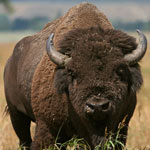
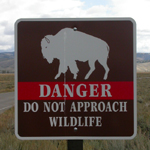

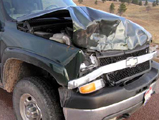
From a Yellowstone study:
“apparently unusual actions or warning activities by bison just before they charged. Bison ‘false-charged’ in only one case, stamped feet in one case, and snorted in another case. In two cases, the bison shook its head before charging. Rolling on the ground (wallowing) immediately preceded two charges. In three cases, bison butted trees just before they charged toward humans. Tail-raising is commonly considered a sign that bison are agitated. We found that snorting, head shaking, foot-stomping, tree-thrashing, or wallowing may also be warning signals that a bison is about to charge.”
“Despite their size and seemingly slow moving habits, bison are surprisingly agile and can be quick to react.”
(Bison can run three times faster than humans can sprint. Bison can spin around faster than a horse. Don’t count on a bison giving warning. Stay a minimum 75 feet (or more) away from all large animals so you won’t contribute to further studies.)
In this photo of a bison about to cross a road, note the size of the bison in comparison to the people and their cars. (Bison are 10-12 feet long, 5-6 feet tall at the shoulder, males weigh up to 2,000 pounds – about the same weight as a Scion XB or Volkswagen Beetle.) If the bison decided to change his direction of travel, or move quickly, people could have been injured. Children trying to stand/hide behind an open car door could be caught between the door and the vehicle if the bison moved quickly and charged the door.
I moved most of this section when it became too long. Before a Bison Charges
__________________
Everyone who was taped in this one-minute-long video
should have been getting far away from these elk,
not staying to watch or photograph (even hiding between their cars):
https://www.nps.gov/media/video/view.htm?id=160DA6A5-1DD8-B71B-0B0E5161E5EF5838
and they should have gone to safety much sooner than the woman in this photo:
__________________________________________
They were just taking a selfie. . .
__________________
The NPS warns: “While mountain lions generally prefer to avoid people, aggressive behavior can be caused by a number of factors including: a mother protecting kittens, a juvenile cat learning what is and is not prey, an older, injured, or ill cat who is stressed for food and approaching non-typical targets in desperation, or a curious cat whose ambush instincts are triggered by human behavior” (such as running).
Yosemite National Park says: “Watch children closely and never let them run ahead or lag behind on the trail. Talk to children about lions and teach them what to do if they meet one. Never approach a mountain lion. Don’t run, but hold your ground or back away slowly. Face the lion and stand upright. Do all you can to appear larger. Grab a stick. Raise your arms. If you have small children with you, pick them up. If the lion behaves aggressively, wave your arms, shout and throw objects at it. The goal is to convince it that you are not prey and may be dangerous yourself. If attacked, fight back!”
___________________________________
Grand Teton National Park birds has photos and details about the most common ones we can hope to see
including Bald Eagle, Red-winged Blackbird, Canada Geese, Clark’s Nutcracker, Golden Eagle, Great Blue Heron. Great Gray Owl, Harlequin duck, Loon, Magpie, Merganser, Northern Flicker (woodpecker), Osprey, Ouzel, Pelican, Peregrine Falcon, Ptarmigan, Raven, Sandhill Cranes, Steller’s Jays, Trumpeter Swan , Western Meadowlark, and Western Tanager, with links to calls / songs from most of them to listen to.
and you can Download photos of over a hundred birds of Grand Teton National Park
https://www.audubon.org/climate/national-parks/grand-teton-national-park
___________________________________
__________________
The main page about our trip to Grand Teton National Park is Grand Tetons
(Note to on-line users not in my classes: this is a study sheet. It is not complete instruction in the topic named in the webpage title.)
The author of this webpage, (written as a homework reading assignment for my students), does not give any warranty, expressed or implied, nor assume any legal liability or responsibility for the accuracy, completeness, or usefulness of any information, product, or process included in this website or at websites linked to or from it. Users of information from this website assume all liability arising from such use.
